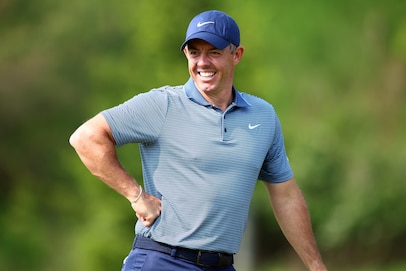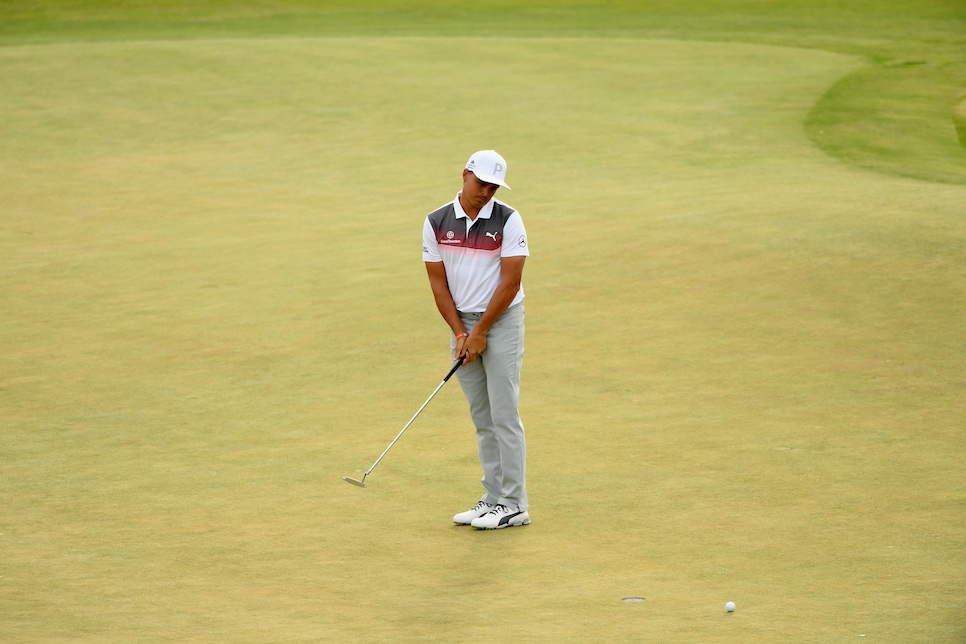Jim Furyk made his U.S. Open debut in 1994 at Oakmont, which next week hosts its record 10th national championship. A native of West Chester, Pa., Furyk gets slightly misty-eyed recalling how meaningful it was for him to be playing his first U.S. Open in his home state and doing so at the championship where Arnold Palmer took his emotional curtain call.
Furyk also will never forget his first visit to the famed Pittsburgh area club about month before the ’94 championship to get a glimpse of what is the toughest layout in the U.S. Open rotation.
Though he grew up in the Philadelphia area—the first U.S. Open he ever attended was the 1981 championship at Merion won by David Graham—Furyk is a devoted Pittsburgh sports fan, particularly partial to the Steelers. He has family members who are members at Oakmont, and his fraternal grandmother Elsie Furyk actually lived in a retirement home next to the club and passed away there within sight of the 18th fairway just a few months before the ’07 championship.
A cousin, Curt Coulter, hosted Furyk for a practice round in ’94 and tried to be helpful by pointing out the countless trouble spots, but Furyk, then a rookie on the PGA Tour, thought his well-meaning relative was being a bit too helpful in that regard.
“We got to about the sixth hole, the par 3,” Furyk recalled, “and he had been telling me, ‘You can’t hit it here, you can’t hit it here, you can’t hit it there.’ So we get to the seventh hole, and I say, ‘Hey Curt, do me a favor and tell me where I can play from, where I can miss it and where I can get up and down.’ And he said, ‘Oh, I never thought of it that way.’ And then he really helped me. I was already nervous; it’s the Open. I didn’t need to know where not to hit it. But I drove home that night feeling a little better about how to play Oakmont.”
What you need more than anything in the U.S. Open is patience, patience and patience. Which is so much easier said than done
2003 U.S. Open champion Jim Furyk
Furyk acquitted himself well in that championship, finishing T-28 at eight-over 292 after rounds of 74-69-74-75. Also T-28 that year was four-time champion Jack Nicklaus. Of course, Furyk knows this. “Pretty cool, huh?” he mused.
Though not among the longer hitters on the tour during his prime, Furyk was a straight driver of the ball, and he proved to be a proficient U.S. Open competitor. He won the 2003 title at Olympia Fields and finished in the top five seven times, including second place on three occasions. Two of the three came the last two times that Oakmont hosted the championship, in 2007 and 2016.
More on the U.S. Open  U.S. Open U.S. Open 2025: Requiem for Dustin Johnson, and the day he became who he was always meant to be
U.S. Open U.S. Open 2025: Requiem for Dustin Johnson, and the day he became who he was always meant to be  Instruction Arms Race: Inside the physical transformation taking place in pro golf
Instruction Arms Race: Inside the physical transformation taking place in pro golf  Majors U.S. Open 2025: USGA’s response to driver testing—’We just don’t see high numbers of failures’
Majors U.S. Open 2025: USGA’s response to driver testing—’We just don’t see high numbers of failures’
In 26 appearances, Furyk made the cut 22 times. So the guy is familiar with the USGA philosophy on U.S. Open setups and with the particularly pernicious nature of a U.S. Open at Oakmont. He has seen it all, the events in which the USGA got the setup exactly right, those that skirted the edge of what might be considered an arduous but still reasonable examination, and those that spilled over into the realm of unfairness or even, in rare instances, farce.
On the rare occasion, he might have encountered all three in one championship.
Of course, what constitutes unfair is in the eye of the club holder. And where the line exists between a sturdy setup and one untethered from sensibleness is somewhat of a moving target—and a source of constant debate. Furyk has some thoughts on this, but he prefaces his comments by remarking, “I’m trying not to sound like a grumpy old guy and say, ‘Well, back in my day. …”
As it relates to Oakmont, what Furyk finds interesting is the notion that the USGA has been able to push one of golf’s most penal designs without ever being accused of crossing over into the realm of unsporting. Maybe some of that is because not much pushing is necessary. “A lot of that is its reputation,” Furyk, 55, said. “Everyone knows that Oakmont is hard—and it’s supposed to be hard. So no one is surprised when it’s hard. And then the fact that it’s had so many U.S. Opens, I think the USGA has a pretty good idea what to do there.”

The Church Pews of Oakmont Country Club, which will play 153 yards longer than it did in 2016.
Fred Vuich
Oakmont will play 7,372 yards, par 70, for next week’s 125th U.S. Open. That is 153 yards longer than the setup that Dustin Johnson conquered at 4-under 276 in 2016. Optimum green speeds will be set at 15 on the Stimpmeter and the rough is supposed to be topped at five inches on Sunday and then left to grow. The wet spring has made that rough lush, and rain is in the forecast for early next week and for the final two rounds. That means hack-out territory. At least those devilish greens will be more receptive.
Furyk does not think hack-out rough is unfair—and he never did. “If I missed a fairway, I didn’t have a problem with taking my medicine, wedging it back into the fairway, getting it on the green somewhere and trying to save par. That’s what the U.S. Open sort of asks you to do,” he said.
Of course, in this era of pure power and near-reckless abandon off the tee, a copious amount of turf lining the fairways only makes more sense, because it is not likely to stop some players appreciably. He has approved of the concept of graduated rough in recent years but that will not exist at Oakmont.
“Today, they just can’t make par 4s long enough,” he said. “Guys hit it so far now that analytics will tell you the fairway is not nearly as important today as it was in 1995. So the USGA, they’ve had to figure out a way to combat that. So when we went to Winged Foot [in 2020], they had the really thick, brutal rough, and they made the fairways narrow and all the guys played the first couple of days trying to get the ball on the fairway and realized that you couldn’t. So they just said to hell with it. They mashed on a driver and figured even if it goes to the rough, they’ll be closer to the green. It’s going to end up there anyway. That’s kind of how Bryson won it.
“So, I had a conversation with Adam Scott the next year, and he was talking about how he played the 16th hole [at Winged Foot], and he said you couldn’t get it in the fairway on 16 and he couldn’t wrap his head around just trying to hit it as hard as he can, even if it goes in the rough. He said, ‘My brain just doesn’t work that way. It took me a couple days to adjust.’ And I can’t get my head around that. So don’t ask me if hack-out rough is unfair.”
That’s not to say that all rough is fair. Furyk points to the 10th hole at Bethpage Black during the 2002 U.S. Open. “Now there’s a setup issue for you,” he said.
Officials didn’t start mowing the grass to fairway height until about 260 yards from the teeing ground, and on a cold and wet Friday, with the hole playing into the wind, players struggled to reach the short grass.
That was an isolated incident, but it’s usually isolated incidents that tend to define the championship setup as a whole. Most often, if the USGA does err, it’s on the putting surfaces. The back pin position on the 18th green at Olympic Club during the second round in 1998 comes to mind, when putts that came up short often rolled back to the player. The 13th green at Shinnecock in the third round of the 2018 championship, where Phil Mickelson ran after his ball and then hit it while it was moving, is another example. Zach Johnson claimed that the USGA lost the course when it was primarily the 13th and 15th greens that were the issue.

The two most recent U.S. Opens at Shinnecock have been examples of extreme setups gone too far.
Ross Kinnaird
In Furyk’s mind, a setup that crosses the line is one featuring greens that repel well-struck shots from the fairway with something less than a 5-iron—depending on angle and how deep into the green the ball lands. Not every shot that hits a green deserves to remain on it. He figures that the USGA can control the receptiveness of the putting surfaces during championships in which there is no rain.
Easily the most severe setup Furyk encountered, the one for which the USGA was universally criticized, was the final round of the 2004 U.S. Open at Shinnecock, when the scoring average on the par-70 course soared to 78.7. Twenty-eight players failed to break 80 and no one broke par. Furyk remembers that day clearly, when he closed with a 79 and tied for 42nd at 18-over 298 as the defending champion.
“You tend to hear the question every year about did the USGA cross the line here or here, and, look, it’s supposed to be tough. But they definitely lost the course in 2004,” Furyk said. “That last day was so hard, and the seventh hole was a huge problem where they had to stop play and water the green. I was on the course when Kevin Stadler and maybe Billy Mayfair [it was actually J.J. Henry] were on the seventh green. I think I was on No. 3 fairway when they were on seven green. I hit my approach, putted out, hit my drive on four, walked out to my ball and they were still on the green. There was a four-group backup by time I got there. After that, we started seeing a few setups that went too far the other way.”
That won’t be the case at Oakmont. As it should be, Furyk said.
“What you need more than anything in the U.S. Open is patience, patience and patience. Which is so much easier said than done,” he said. “I lost my patience a number of times and played some very poor rounds. I played a really poor Sunday round at Southern Hills [in 2001] and just kind of lost my sh– during the round where pars became bogeys and bogeys became doubles and I was mad at myself after the round for letting it get away from me. Oakmont can get to you like that. I think the year [Angel] Cabrera won, in 2007, I shot 75 in the second round and still had a chance to win. I kept it together.
“I was comfortable going to Vegas and shooting 25 or 30 under par, but I was also comfortable grinding out pars probably because that was the MO of the U.S. Open. You didn’t want to do it 20 times a year, but I didn’t mind having to get the ball up and down and limiting mistakes instead of multiplying them, fighting for pars knowing that was a good score. That was the test. I accepted that. That was one of my strengths. That doesn’t mean I liked every setaup. I didn’t like Merion the last time we were there [in 2013]. But I had to play it like everyone else instead of worrying about it whether it was fair or unfair.”
Indeed. Guys who have time for that are guys who have crossed their own line—right through their own names.
This article was originally published on golfdigest.com



